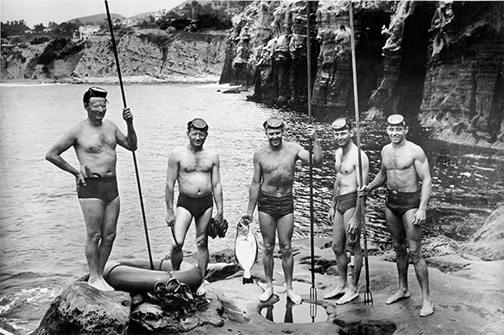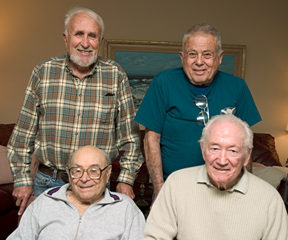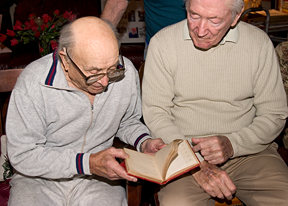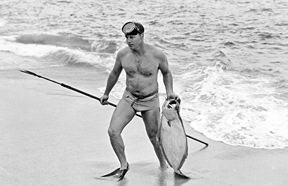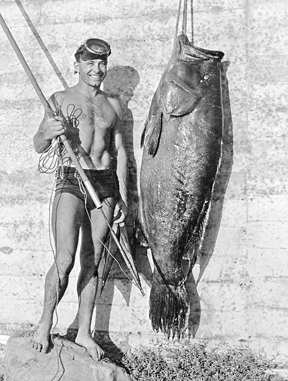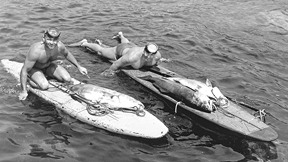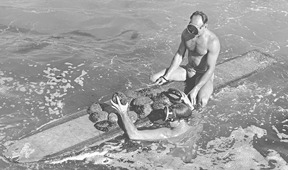|
AFTER 72 YEARS, THE FAMED SAN DIEGO BOTTOM SCRATCHERS CLUBHAS CLOSED ITS DOORS.
Sixty-five years ago a pair of gogglers swimming off a La Jolla beach, armed with glorified pitch forks, spotted a 500 pound “reef,” which was really a giant black seabass. By today’s standards, approaching such a prize with hand-held 5-prong spears seems comical. On the surface, the two intrepid divers settled on a plan. Jack explains, “Wally was to hit him on the right while I smacked him on the left.” The fish was deeper than anticipated and only Jack was able to jab the fish with his spear. Instantly, the three prongs that managed to penetrate were bent over at 90-degrees as the beast bolted. Jack says, “Our wives reported that the spear handle went past like a sub’s periscope, bound for Japan.” Imagine discovering the fecund waters off San Diego where lobster and abalone fought for space among the rocks just a stone’s throw from the beach. After early forays into the surf zone, the fearless Bottom Scratchers explored further offshore where they discovered a veritable aquarium stocked with broomtail grouper, giant black seabass, white seabass and yellowtail—fish that defied their imaginations. One Bottom Scratcher remembered the incredulous reaction from beach goers who watched the “frogmen” emerge from the surf with an incredible catch. On one of the bluffs above, a Midwestern family fresh from a Hollywood tour watched as one of the bare-skinned divers wrestled a 150-pound black seabass from the surf. Knowingly, the father turned to his family shouting, “See I told you it was just a rubber fake—too big to be real.” Early this year, after 72 continuous years, the oldest and most famous freediving club held its last meeting. I was honored to document the ceremonial closing of the venerable San Diego Bottom Scratchers Club. The meeting began with a simple lunch around Jack Prodanovich’s kitchen table. Of the 5 remaining club members 3 joined Jack, Jim Stewart, Bo Smith and Marty Pasos—only Emil Habecker, living in Texas, was absent. In spite of dwindling membership, hearing aids and an oxygen machine, it became clear that the group’s spirits were as bright and untarnished as if they had just emerged from the surf 70-years ago. After lunch, we retired to Jack’s living room where he produced his little red diary complete with cryptic notes encompassing his diving career. Soon Jack and Bo began a spirited discussion with Bo shouting into Jack’s best ear. With smiling faces and animated arms, the pair relived a dive completed before most of us were born.
Magically these 90-year olds, bent with age, began to grow ever younger before my eyes. I was reminded of the T.V. show Cold Case as the years melted away and I felt goose bumps as Jack’s wife Gertrude told the story of a lobster catch that could have been yesterday. The spirits of these pioneering divers has not dimmed one bit with the passing of 70 years.These humble and modest men, with disparate careers, became united by their mutual love for the ocean. Only the high adventure of shark-ridden unexplored waters could satisfy Bo Smith’s hunger for living on the edge. Bo smiles as he recalls his return from the W.W. II Pacific Theater where he piloted his carrier-based aircraft into 83 combat missions. In the space of just two years, Bo had survived two bail outs at sea and a crash landing after a fellow pilot got too close and ground off 4-feet of his wing tip. When the war ended, Bo was running on adrenalin. Having a tough time adjusting to peace he says, “Just after the war, I was drinking and smoking too much and the late night partying was killing me. Jack Prodanovich and diving gave me back my life.” Bo recalls, “One day my dad showed me a picture of Jack in the newspaper holding up a huge grouper. Coincidentally, I met Jack 2 weeks later when I applied for a teaching job in San Diego—one of the few jobs available at the time. I discovered Jack working in the maintenance shop and he offered me a mid-day swim at the beach. Jack infected me with his desire to dive in the ocean and I eventually joined the Bottom Scratchers." From his humble start as woodshop and math teacher, Bo rose to the top of the San Diego school system administration holding the position of principal for over a decade.After meeting Bo, Jack had shot a large grouper, which had lodged itself in the rocks. “I was so pooped I needed to climb on my board for a rest,” recalls Jack. “Suddenly, a competitive swimmer swam by with his swimming goggles and fins. I asked him for help.” That’s how Jim Stewart, now professor emeritus at Scripps Institute of Oceanography met the club members.The name "Scratchers" came from the members' habit of scouring the ocean bottom for food. "In those days, the ocean was like a freezer—if you were planning a dinner with friends, you went to the ocean to collect fresh food." recalled early member Wally Potts. The club was so exclusive that in the first 15 years only 9 members passed the club’s qualification tests. First, you had to dive to at least 30 feet and bring up 3 abalone in a single dive. The next two qualification dives were made to 20 feet where a wannabe had to bring up a lobster over 3 feet long and finally, he had to bring up a horn shark tail first—barehanded!The Bottom Scratchers either invented or were the first to use the basic freediving spearfishing gear still employed today. Members of the club pioneered each step of the progression from the simple goggle swimmer to consummate blue water hunter. Jack remembers the day that founding member Glenn Orr—The Grand Exalted Walrus—invited him to see the near-shore wonders with his swimmers’ goggles. The goggles distorted vision so badly that Jack got dizzy but by using one eye, the explorers spied for the first time the riches at their doorstep. In spite of the shortages of materials due to W.W.II, the ever- resourceful Jack made his face mask with a single plate of glass and a face seal from a stereoscope, which eliminated the double vision. With the group’s discovery of Japanese masks shortly thereafter, members continued to enthusiastically embrace each new piece of freediving equipment as they appeared. Sometimes years passed before they invented or adopted an item.After the mask came the first fins. Can you imagine frog kicking through the water without them? Jack still recalls in wonder the first time he used fins and the speed they provided. “For the first time, I heard water rushing past my ears and I nearly ricocheted off the 20-foot bottom.” Over the next 10 years they found that they could keep their faces down with a snorkel and the newly developed wetsuit allowed them to stay in the water for more than eight hours as compared to the half-hour with exposed skin. Paddle boards allowed them to extend their range while underwater lights let them work in caves. Each new piece of gear expanded their potential and increased their horizons.Jack Prodanovich was just one of 20 club members, and while others in the club made fundamental discoveries, only Jack carefully chronicled his dives in his little red logbook. I’ll use Jack’s entries to illustrate many of the advances.
In the late 1940s, teased by fishermen’s tales of huge fish in the offshore kelp beds, the team swam out to sea, across the sand—no-man’s land between the near-shore rocks and the beginning of the outer reefs. Almost immediately they spotted fish so big that they defied imagination—broomtail grouper to 200 pounds. This first glimpse forever changed the clan from simple hunter-gatherers into big-game hunters. Here is Jack’s account of his first big-game encounter excerpted from his red book: 6/10/44 Jack realized that his simple hand spear was no match for such big fish. His solution was to invent a power-head, which he designed and machined at home. 9/2/45 Wally Potts joined the club in 1939 and together with Jack, the team pioneered modern speargun technology and blue water hunting techniques. Jack invented and designed the reel using two stainless steel pots. The name “Jackpot reel” came from this originally. Jack showed Wally the reel and asked him to help out. Wally was skilled in plastic and adapted the reel to a plastic design. Jack also designed the brake mechanism for the reel. Jack’s speargun mechanism is still considered by many to be one of the best ever developed. Jack also made the first detachable spearhead.
Soon club members became local legends, which this local newspaper article illustrates: PRODANOVICH FIGHTS MONSTER HOUR AFTER ENCOUNTERING IT -- by Harold Keen In an hour-long battle 1/4 mile off Boomer beach, La Jolla, yesterday afternoon, Jack landed one of the largest fish ever caught single handed by underwater spearing -- a 207 pound Broomtail Grouper. Prodanovich, Pt. Loma High school custodian who weighs 150 pounds, earlier in the week had caught a 100-pound grouper in a similar manner. He fought the mortally wounded, desperately thrashing sea giant with a slender paddleboard as his only security until the fish’s strength played out and he was able to tow it in. Lands Presidency, too The catch qualified Prodanovich for the 1946 presidency of San Diego’s famed “Bottom Scratchers” club. To be a “Bottom Scratcher” you must at least be able to bring up three abalones from a depth of 30 feet, catch a shark of any kind with the bare hands and haul up a live lobster from a slippery underwater ledge. The 12-year-old club has nine members. Stuck between ribs Prodanovich’s mammoth fish was struck squarely between the ribs by a power-driven slip-point spear that went completely through its body. Prodanovich dove 20 feet to make the strike, then returned to his paddleboard to manipulate the 50-foot heavy cord line connected with a cable attached to the spear head. The line was linked to the paddleboard and the fish gave him a wild ride as it alternately plunged and surfaced in its death throes. “I’d start towing it toward the beach, when it suddenly would take off again.” Prodanovich explained. “All that fish needed was a conning tower and it would have looked like a submarine.” Bottom Scratchers wear a diving glass, modeled after those used by Oriental pearl divers, and Prodanovich, in addition, wears spectacles beneath the glass in order to see what he’s doing under water.
Everything the explorers experienced was new—including a close call with shallow-water blackout. Jack remembers sitting on his paddle board removing a spear point from a grouper. Wally, stalking 5 large yellowtail, made two dives in quick succession. He shot a large one on his third dive. Underwater, he pursued the escaping fish. Each time its tail came within his grasp, it burst ahead, tantalizingly just out of reach. Finally grabbing the fish, he headed for the surface. Dodging a clump of kelp, he aimed for clear water above. Realizing he was not going to make it, Wally remembers dropping the fish but he does not remember dropping his pole spear. “The last thing I remember was seeing a cloud of little white stars before my eyes.” Jack remembers, “I couldn’t find Wally—he should have come up. I yelled to friends in a nearby boat for help. Shortly, Wally surfaced, lifeless, arms dangling. I grabbed him by the head and pulled him face down onto my paddle board. I knew he was dead for sure. In desperation, I pounded him on the back. Wally woke up mid-sentence saying, “Gol darn, I just about had him.” Later, Jack attributed Wally’s good fortune to his tendency to float (in the day before they began using weightbelts.)
During the early 1950s, Jack improved the first spearguns. Here is Jack’s account of the first fish he took with his gun:5/31/51 These wonderful excerpts show how the divers were learning and adapting: 6/11/51 4/6/52 7/19/53 7/23/53 6/3/57 In the 1960s and 1970s, many in the group set their sights on the waters of Baja California, Mexico where member Marty Pasos flew Jack and the crew to his beachfront palapa. After landing, the explorers trekked the short distance to the shore. Below Jack introduces the float ball and line, forerunners of the terminal gear used by blue water hunters today 5/20/73 5/21/73 After 40 years, as these last two entries attest, Jack was on the cutting edge of blue water hunting gear development. 5/24/73 5/7/85 In May 1949, the club was featured in a 17-page National Geographic article, Goggle Fishing in California Waters by David Hellyer with photographs by Lamar Boren. Later Boren filmed the first segment of the immensely popular series Sea Hunt using the Bottom Scratchers as models. Jack made much of the equipment used in the show. Series photographer Boren loved the guys and his wonderful pictures help preserve the club’s place in history. These first enthusiasts contributed heavily to a new magazine, which sprung up in Southern California to chronicle the sport as everyday people began to explore the oceans—Skin Diver Magazine. Jack became a real "One-Eye-Jack" after the self-propelled spear prop he made for a James Bond movie, "The Spy Who Loved Me" ricocheted off the side of the pool blinding him in one eye.The Bottom Scratchers were responsible for making spearfishing legal. Early California laws forbid taking fish with a spear. The daring exploits of the Bottom Scratchers helped make a lasting change to the fishing code allowing spearfishing by divers. One legislator observed, “Anyone who wants a fish badly enough to hunt him out in his own element deserves the right to spear him.” Over time the club’s conservation ethic grew. When the members learned that the broomtail grouper they hunted from La Jolla represented an insolated and finite group, they stopped hunting them. While club members developed the first power-assisted spear heads, they soon abandoned their routine use declaring them as unsportsmanlike and limited their use to self-defense . These were later called "Bang Sticks." Jack developed the bang stick for defense against aggressive sharks. These were commercially produced by a large equipment company. They constantly assisted the Department of Fish and Game by updating fish sizes and habitats. Jack’s red diary is full of references to observations he passed on to oceanographers. The club also worked with Department to limit the number of abalone a diver could take. They saw how the old limit of 10 was leading to over-utilization of this resource. A large number of club members were connected to the Scripps Institute of Oceanography. For many years Jim Stewart was chief diving officer for Scripps Institute. Bill Batzloff was an early expert in rubber and made many wetsuits for Scripps. Other Scripps divers included Connie Limbaugh, Earl Murray, Carl Hubbs and Emil Habecker.
|
